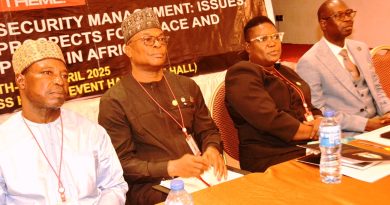What PRNigeria Fact Check Discovered On Alleged Terrorists’ Involvement In COAS Attahiru’s Plane Crash
Findings by PRNigeria, while not ruling out other factors, have revealed that there was evidence of severe weather conditions amidst rainfall and storms during a plane crash that claimed the life of Lt. Gen. Ibrahim Attahiru, a former Chief of Army Staff, COAS, and 11 other senior military officers in 2021.
Recently, a former General Officer Commanding (GOC) 1 Division of the Nigerian Army, Maj Gen Danjuma Ali-Keffi (rtd), in an interview with THISDAY, alleged that the air crash that killed former Chief of Army Staff, Lt Gen Ibrahim Attahiru, was linked to terror sponsors.
But to analyse Gen Ali Keffi’s theory, PRNigeria Fact-check reviewed images and video footage of the crash site and observed no crater or impact on the crash area.
However, a senior military officer who asked not to be named due to lack of authority argued that the Load Classification Number (LCN) of any international airport is strong enough to withstand heavy aeroplane crashes.
“The aircraft that was conveying the COAS and his entourage was a King Air 350 aircraft which is relatively categorised as a small transport aircraft that crashed while it was trying to land on the runway with reduced speed and would not create a crater at the sight of the crash,” he argued.
LCN refers to a numerical value assigned to the pavement strength of runways and taxiways at an airport. It indicates the maximum weight of an aircraft that the pavement can safely support.
Airports publish their LCN values for different locations within their facilities, allowing pilots to choose appropriate aircraft or adjust take-off and landing procedures based on the pavement strength.
The International Civil Aviation Organization (ICAO) has established standard guidelines for the design, construction, operation, and maintenance and the Federal Aviation Administration (FAA) Advisory has detailed documents on airport pavement design and construction, including the use of LCN values.
A complete review of the video of the crash site shows trees, grasses, and sandy areas around it, which means that the aircraft did not crash within the airport area where an LCN might be considered applicable.
Given the theory that the aircraft might have landed with reduced speed, the PRNigeria fact check searched online for reports of causative factors leading to the plane’s crash.
Findings reveal that following the incident, the Nigerian Air Force (NAF) mandated the Accident Investigation Bureau (AIB) to lead the investigation into the crash, as contained in a press release by AIB itself on May 25, 2021.
Months later, the AIB Commissioner and Chief Executive Officer, Akin Olateru, submitted an interim report on the crash to the Chief of Air Staff, Air Marshal Oladayo Amao, in Abuja.
A joint statement by Gabkwet and the general manager of public affairs at AIB, Tunji Oketunbi, stated that the preliminary report contained 27 initial findings and eight safety recommendations for immediate implementation.
That was all that was heard of the crash.
The PRNigeria fact-check team tracked the AIB via its website, https://aib.gov.ng/, but could not find reports about the crash.
It went to its contact menu and found a telephone line dedicated to responding to media inquiries.
When contacted, the receiver on the other end of the line on behalf of AIB told PRNigeria that after submitting its preliminary investigation, it requested additional “things” from the Nigerian Airforce, which were major determinants of the outcome of the final report.
Still, they were not given; hence the investigation was not concluded.
When asked if preliminary findings indicated that there was sabotage by “terrorist financiers” as alleged by General Ali Keffi, he said, “You know, we don’t deal with political and criminal aspects of such matters we deal strictly with investigation of facts.”
When asked why the AIB did not make the preliminary findings public, he argued that it was not a civil aviation accident.
Hence, the military had the onus to decide on that, and it was not the AIB’s responsibility to publish the findings.
Pressed to reveal the actual cause of the crash, he confirmed that weather conditions were one of the known factors but argued that “preliminary is not likely to tell the cause of the accident, but some factual information found and safety issues conclusion and cause is very dependent to the full report which we didn’t have the chance to complete.”
PRNigeria then contacted a senior NAF for further comments as regards the AIB’s preliminary report.
A top Air Force officer who pleaded anonymity because he was not authorised to speak on the matter said it was due to “extreme weather conditions.”
PRNigeria discovers that in one of his arguments, General Keffi also alluded to the same terrible weather in his interview.
In the Thisday interview, Keffi said, “…I even suggested that they should advise Abuja of weather conditions to have the flight cancelled. At that point, I was informed that the aircraft was airborne (at about 1745 hrs). I became concerned about whether the plane could land at the airport in such heavy rainfall and storm (the rain had started falling then).
“Thus, I was not surprised when Air Commodore Ilo informed me that we had to go to the Civil (International Airport) as the NAF runway was not long enough to enable the aircraft to land under the atrocious weather conditions. We then set off for the International Airport but at a snail speed due to the heavy rainfall accompanied by shale (ice particles).”
PRNigeria then searches for the possibility of an aircraft exploding in thunderous weather conditions while airborne and landing without a noticeable crater or impact.
Findings reveal the possibility is extremely low, although some weather phenomena associated with thunderstorms can pose certain risks and cause malfunctioning.
While uncommon, lightning strikes can damage aircraft systems and electronics.
Modern aircraft have lightning protection systems to minimise damage and ensure safe operation.
However, in rare cases, extensive damage due to lightning strikes could lead to catastrophic failures.
The Federal Aviation Administration (FAA) emphasises avoiding severe thunderstorms for safety reasons.
However, aircraft are designed to withstand various weather conditions, and pilots receive extensive training in handling turbulence and other thunderstorm-related challenges.
Meanwhile, the National Transportation Safety Board (NTSB) database shows no accidents attributed solely to the effects of thunder or turbulence.
Accidents involving lightning strikes are also infrequent but not totally out of the question. Instances that bolster the possibility of an aircraft catching fire and exploding in thunderous weather conditions are negligible but not impossible.
PRNigeria, therefore, concludes that there is INSUFFICIENT EVIDENCE to prove that that the cause of the crash was linked to terrorist financiers as severe weather conditions from official findings also played a more relatable role in the incident.
By PRNigeria




